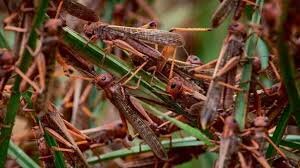By Brian Moseti
 For most of February and the early March, Abdi Elema, a resident of Isiolo County, was fighting to send away the migrating desert locusts that had flown into his grazing lands.
For most of February and the early March, Abdi Elema, a resident of Isiolo County, was fighting to send away the migrating desert locusts that had flown into his grazing lands.
He did not have any specialized tools for the task and was left to manually chase after them, while hitting empty pans and blowing whistles. The destructive insects hate noise and this tactic worked for a while, until the swarms, which were flying in from Ethiopia daily, became too large for his small family to handle.
“We had given up as we did not have enough capacity to fight the pests. Luckily, the government stepped in and sprayed chemicals, which quickly eradicated the pests,” said Elema.
However, recently, some locust nymphs have begun to appear in parts of Garbatula, where Elema resides, creating fear of a fresh locust attack, but this time emerging from within.
“We suspect that the locusts had laid eggs around, which have now hatched,” said Elema.
James Ntajirin, a resident of Samburu county confirms similar sightings in his home town of Baragoi, as does Tito Munyalo, who is now fearful that his crop of green grams in Mutomo, Kitui County, is now exposed to the insects, which are capable of destroying enough food for 35,000 people in one day.
The Food and Agriculture Organization (FAO), confirms that the young locusts have been spotted in the three counties, as well as in Tharaka Nithi, Turkana, Marsabit, Garissa and Embu.
Related News: Industry has pesticides ready for locust spraying, as swarms threaten on delays
It the number of locusts could increase 20 times during the rainy season, which has just begun in most of the country, further extending the locust crisis, which has already been the worst for the region in 70 years. The biggest worry is that it might be difficult to source the chemical sprays needed to contain the pests as most of the air carriers remain paralysed by the Corona Virus Disease 2019 (COVID-19) management efforts.
"The biggest challenge we are facing at the moment is the supply of pesticides and we have delays because global air freight has been reduced significantly," said FAO’s resilient team leader for East Africa Cyril Ferrand.
However, Ferrand promises that his organization, which recently raised $111.1m of a $153.2m appeal to fight the insects, will work tirelessly to ensure that it is contained before it causes further damage.
"Our absolute priority is to prevent a breakdown in pesticide stocks in each country. That would be dramatic for rural populations whose livelihoods and food security depend on the success of our control campaign," he said.
Meanwhile, farmers like Munyalo are taking proactive measures, including the use of homemade biopesticide sprays as they try to protect their farms from invasions.
“We sometimes use neem extracts to kill other insects and that is what we are now spraying around hoping that it works for the desert locusts too,” Munyalo said.
Although neem has not been approved for widespread use as a biopesticide, environmental activists like Herman Bigham see it as one of the solutions for the locust menace.
Related News: Fast action needed to head off ‘biblical’ famine
“Neem kills more than 350 insects that are harmful to plants, among them locusts, while remaining completely safe and non toxic to humans and other helpful insects like bees,” said Bigham.
Desert locusts are considered the most destructive migratory pests in the world. A single swarm occupies one square kilometre and contains up to 80 million locusts. In addition, the insects travel fast and have the capacity to cover 200km in one day.
Experts agree that the best way to eradicate the pests is to destroy their ability to reproduce by killing the nymphs and young adults. This is best achieved using spraying aircraft, which make it easier to cover large areas over a short period of time.
For farmers like Elema, Ntajirin and Munyalo, it is their hope that the government and other partnering agencies, like FAO, will work hard to tame the pests, which have already ravished 64 per cent of the pasture lands in Somalia, while wiping out 356,000 tons of grain including sorghum, maize and wheat in Ethiopia, creating a food crisis for one million people.
















Comments powered by CComment